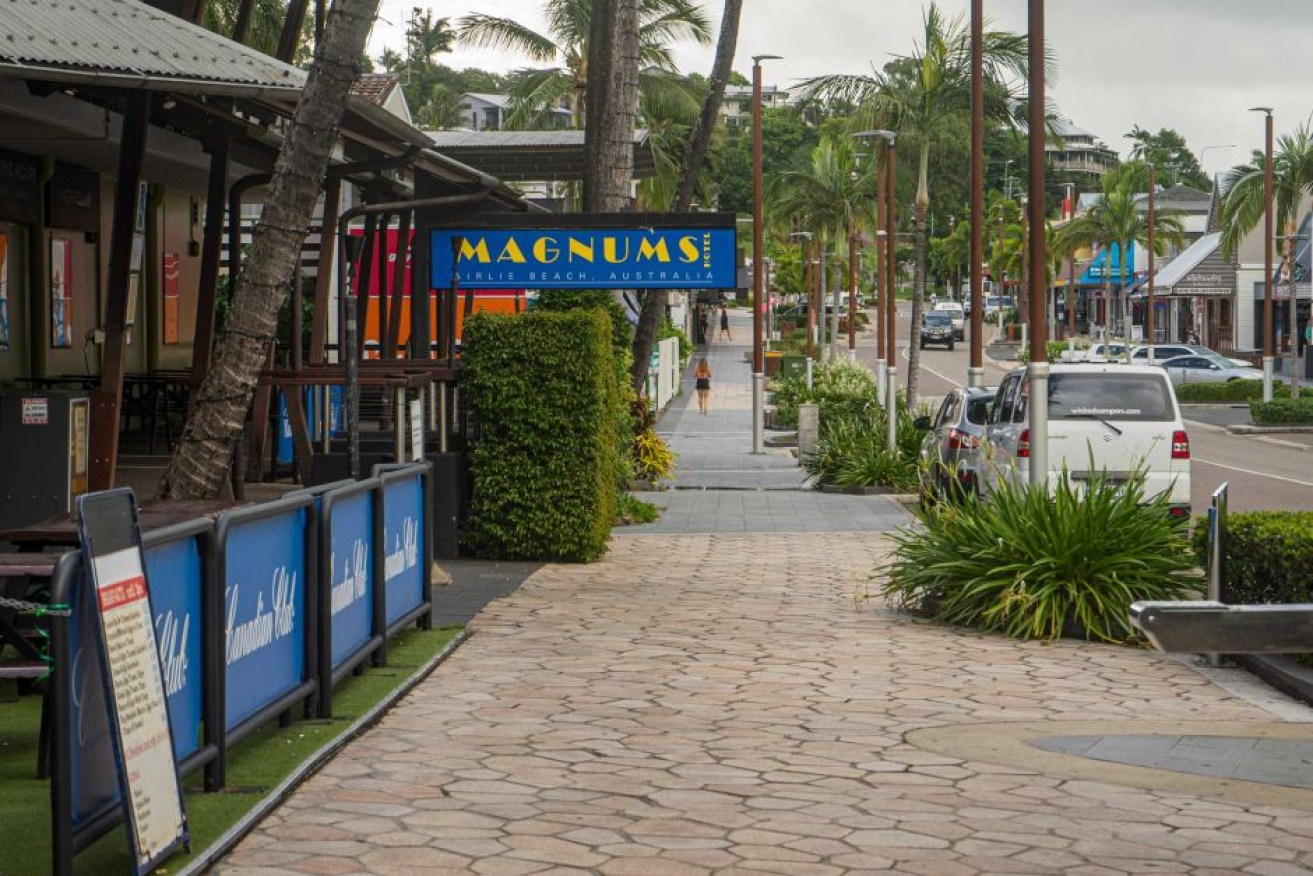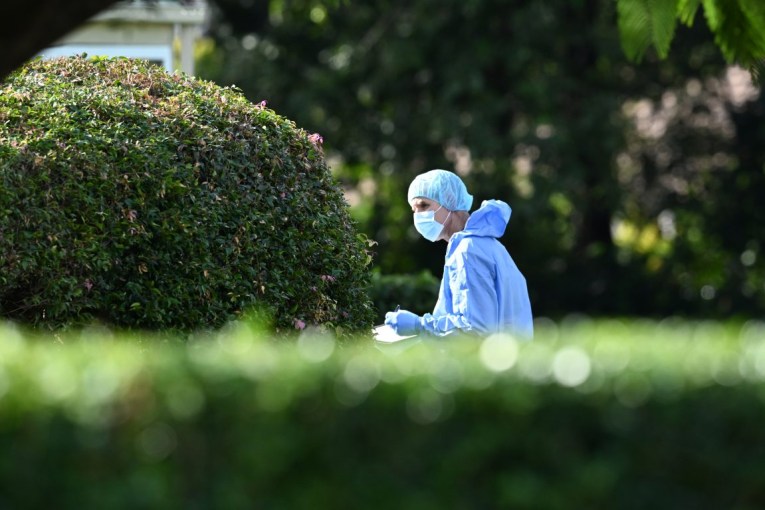Cairns, Byron will be slowest to emerge from economic rubble
Hard-hit tourism and hospitality hubs Byron Bay and Cairns are among important regional centres likely to emerge slowest from the economic rubble of the coronavirus crisis, says an international team of researchers.

The once bustling main street of Airlie Beach is now empty. ABC News: Tim Shepherd
But cities and towns with diversified economies are better placed to recover faster, according to analysis of the expected impact of COVID-19 across Australia.
As the Federal Government rolls out a massive $130 billion JobKeeper relief package for millions of newly unemployed Australians, researchers have revealed an economic vulnerability index (EVI) of 20 communities, based on the resilience of their local economies.
And tourism towns are prevalent, with Queensland accounting for six cities and towns on the most-vulnerable list, including Cairns, empty of tourists since the pandemic ended inbound flights from China in January.
South of the recently closed Queensland border, Byron Bay has just experienced its first Easter in 30 years without Bluesfest, which pulled in 105,000 people last year.
The northern NSW beach haven normally attracts 2.1 million tourists a year but is reeling from the cancellation and rescheduling of a raft of major local events, including another major music festival, Splendour in the Grass. Beaches and backpacker cafes are closed and local officials are telling visitors to stay away.
Also listed as vulnerable are Sale and Lakes Entrance, two major centres in Victoria’s bushfire-traumatised Gippsland region.
The EVI research found centres relying on narrow economic bases were most at risk from lasting coronavirus disruption, while towns and cities with broader economic foundations, including mining and agriculture, were more likely to recover faster.
The collaboration between University of South Australia Business School, Newcastle University’s Hunter Foundation Research Centre, and George Mason University in Washington DC, considered the economic impact of COVID-19 on regions “likely to see the largest and most immediate negative effects on local economic activity and labour markets”.
The researchers believe the study can help governments better plan for calamities that shut down local industries.
Regions focused on tourism and hospitality, and major centres servicing oil and gas industries, including Sale and Lakes Entrance in Victoria, and Karratha, in northern Western Australia, were likely to struggle longer.
However, Karratha’s near neighbour, Port Hedland, with an economy spread across mining, transport, construction and manufacturing, and north-west Queensland’s mining-and-agriculture centre Mount Isa, were better placed to bounce back, according to the report.
Mount Isa ‘robust — for now’
University of South Australia Business School Professor Andrew Beer said the research team focused on regions that relied on industries most likely to be affected by COVID-19.
“Industries such as cafes, tourism and hospitality are very much affected by social-distancing measures,” Beer said.
“In terms of economic impacts, you had to develop an index that indicated which parts of Australia’s economy and its citizens are most likely to have negative impacts.
“Our examination of market indicators in the earliest days of this unfolding calamity suggested that the sectors most likely to feel the first economic effects include hospitality and leisure, transportation, employment services (agencies), travel arrangements, and oil and gas mining.”
But Beer said that, while the EVI list was based around industry dependencies, it was not a measure of “absolute vulnerability”. The pandemic, he said, would affect every region and town in Australia, and research would continue as the impact became better understood.
Beer said Mount Isa, for example, a city of about 18,000 people with no confirmed coronavirus cases to date, had an economy supported by both mining and agriculture, which put it in the least-vulnerable category.
“While Mount Isa at the moment is robust in terms of economic performance and not likely to suffer with downturns, it may well become exposed to longer-term global economy slowdowns,” Beer said.
“But at this stage, it’s not evident in the data.”
Beer said there were ways places that are at risk could respond to these challenging times.
“Mayors, state governments and business leaders should be looking at ways to develop new markets and new industries, closely related to their existing strengths, as part of a more diversified, but still globally competitive, industry base.
“For places like Roma, this might be in logistics, while Chinchilla could further develop its strength in agriculture.
“Lakes Entrance and Cairns need to plan now how they can hit the ground running when first local, and then international tourism starts to open up.”
‘In middle of a storm’
But with an economy driven almost solely by tourism, Airlie Beach-Cannonvale, gateway to Queensland’s Whitsunday Islands, is among the 10 most vulnerable centres identified by the research.
Tourism Whitsunday CEO Tash Wheeler conceded the area had been hit hard but tourism operators were working together to “come out on the other side”, including creating campaigns and maintaining islands for when travel and social-distance restrictions were lifted.
Nevertheless, a lot of local businesses would be relying on JobKeeper and JobSeeker stimulus packages.
“Without a doubt these next three to six months are going to be very challenging,” she said.
“While we’re in the middle of the storm right now, people are thinking ahead and looking at what we can do . . . we’ll all be working together,” she said.
‘Heaps of assumptions’ in research
University of Queensland Associate Professor of Economics Renuka Mahadevan said all research into the impacts of the coronavirus was important but not complete, and more akin to “accumulating historical evidence” to draw on in the future.
She said only now were lessons and research from the SARS epidemic applicable to COVID-19 and in the future current research would be used in the same way.
However, Mahadevan said the international EVI research was a narrow field and should be viewed as such.
“In this piece (of research) they are only looking at the economic effects and that’s actually quite narrow,” she said.
“I’m a realist and an economist so I would rather have some information than no information … but also be aware that in all this modelling there are heaps of assumptions.
“Take everything with a grain — or perhaps a bag — of salt behind these numbers, but it’s a necessary evil.
“At least if those numbers are coming out it means people are trying to model, people are thinking about it, and that’s important.”
– ABC / Kelly Butterworth, Krystal Gordon and Timothy Shepherd












